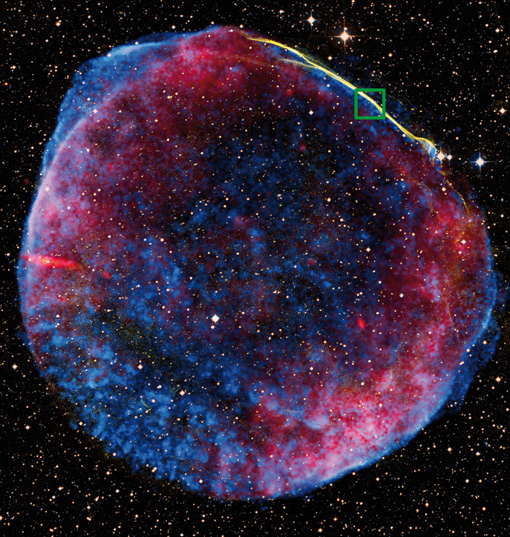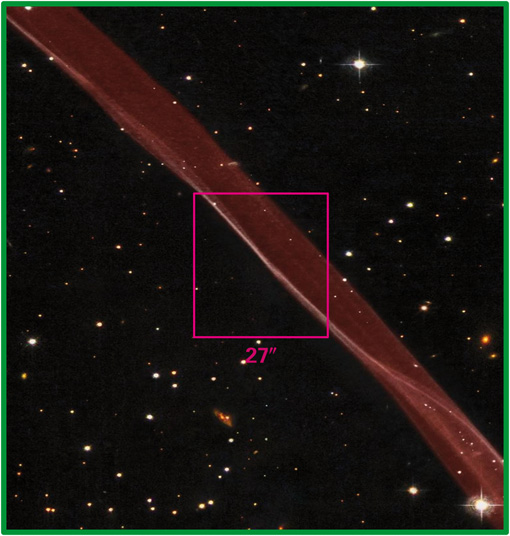|
|
MPIA Science Release 2013-02-14 |
|
| German version |
Novel approach in hunt for cosmic particle accelerator
A team of astronomers led by Sladjana Nikolić from the Max Planck Institute for Astronomy has observed the supernova remnant SN 1006, probing in unprecedented detail the region where the gas ejected during the supernova meets the surrounding interstellar matter. Such remnants have long been thought to be the source of cosmic ray particles hitting Earth. The observations show, for the first time, the presence of "seed particles", possible precursors of such cosmic rays. The novel approach used by the astronomers promises further insights as to how supernovae remnants act as cosmic particle accelerators. The results will be published on February 14, 2013 in the journal Science.
| Figure 1: A composite image of the supernova remnant SN 1006 combining data from different wavelengths: Radio (red), X-ray (blue) and optical (yellow, orange and light blue). The region of the shock front studied in detail by Nikolic et al. is inside the green rectangle. Credit: X-ray: NASA/CXC/Rutgers/G.Cassam-Chenaï, J.Hughes et al.; Radio: NRAO/AUI/NSF/GBT/VLA/Dyer, Maddalena & Cornwell; Optical: Middlebury College/F. Winkler, NOAO/AURA/NSF/CTIO Schmidt & DSS Larger version for download] |
 |
| Contact | Background information | Images |
When Victor Hess first discovered cosmic ray particles hitting Earth almost exactly a hundred years ago, he had little notion about their origin. Since then, ever more sensitive observations of these particles have turned up a number of sources. Among them are supernova remnants – cosmic blast waves launched by stellar explosions; expanding gas shells flung into space when certain stars end their lives in a supernova.
Where such a blast wave meets the surrounding interstellar medium, there is an abrupt change in density and temperature: a shock front similar to the sonic boom produced by an aircraft going supersonic. This expanding, high-velocity shock front is a natural candidate for a cosmic particle accelerator. Now, for the first time, astronomers have found observational evidence of accelerated protons in these shock regions. While these are not the sought-for high-energy cosmic rays themselves, they could be the necessary "seed particles”, which the go on to interact with the shock to reach the extremely high energies required and fly off into space as cosmic ray particles.
Nikolić explains: "This is the first time we were able to take a detailed look at the microphysics in and around the shock region. We found evidence for a precursor region directly in front of the shock, which is thought to be a prerequisite of cosmic ray production. Also, the precursor region is being heated in just the way one would expect if there were protons carrying away energy from the region directly behind the shock."
The new evidence emerged during careful observational analysis by the Serbian astronomer Sladjana Nikolić (Max Planck Institute for Astronomy) as part of her work towards a doctoral degree at the University of Heidelberg. The key to the new result is a modern technique used by Nikolić and her colleagues, known as integral field spectroscopy, which allows astronomers to simultaneously probe the composition of light received from numerous locations within their telescope's field of view. This is the first time the technique has been applied successfully to a supernova remnant.
Nikolić and her colleagues used the spectrograph VIMOS at the European Southern Observatory's Very Large Telescope in Chile to map a small part of the shock front of the supernova SN 1006, simultaneously analyzing light ("taking spectra") from more than 100 locations within that region. Analysis of the data – one and a half years' worth of hard work – provided detailed information about the way that hydrogen atoms in the region are being excited in and around the shock front, and of the temperatures in front of and behind the shock.
Kevin Heng of the University of Bern, one of the supervisors of Nikolić's doctoral work, says: "We are particularly proud of the fact that we managed to use integral field spectroscopy in a rather unorthodox way, since it is usually used for the study of high-redshift galaxies. In doing so, we achieved a level of precision that far exceeds all previous studies."
The study is also important because it opens up avenues for further research. Nikolić explains: "This was a pilot project. The emissions we observed from the supernova remnant are very, very faint compared to the usual target objects for this type of instrument. Now that we know what's possible, it's really exciting to think about follow-up projects." Glenn van de Ven of the Max Planck Institute for Astronomy, Nikolić's other co-supervisor and an expert in integral field spectroscopy, adds: "This kind of novel observational approach could well be the key to solving the puzzle of how cosmic rays are produced in supernova remnants."
| top |
Contact information
Sladjana Nikolić (lead author)
Max Planck Institute for Astronomy
Heidelberg, Germany
Phone: (+49|0) 6221 – 528 438
Email: nikolic@mpia.de
Glenn van de Ven (co-author)
Max Planck Institute for Astronomy
Heidelberg, Germany
Phone: (+49|0) 6221 – 528 275
Email: glenn@mpia.de
Markus Pössel (public relations)
Max Planck Institute for Astronomy
Heidelberg, Germany
Phone: (+49|0) 6221 – 528 261
Email: pr@mpia.de
| top |
Background information
The study is being published as Nikolić et al., "An Integral View of Fast Shocks around Supernova 1006" in the online version of the journal Science on Febuary 14, 2013.
The team members are S. Nikolić (MPIA), G. van de Ven (MPIA), K. Heng (University of Bern), D. Kupko and B. Husemann (both Leibniz Institute for Astrophysics Potsdam), J. C. Raymond (Harvard-Smithsonian Center for Astrophysics), J. P. Hughes (Rutgers University) and J. Falcon-Barroso (Instituto de Astrofísica de Canarias).
| Figure 2: Close-up image of part of the shock front region of the supernova remnant SN 1006. The image was taken with the Hubble Space Telescope and shows characteristic light emitted by hydrogen atoms ("H-alpha"). The area of the shock front studied by Nikolic et al. is shown as a box. Credit: NASA, ESA, and the Hubble Heritage Team (STScI/AURA) [Larger version for download] |
 |
|
| top |
Images
 |
PR_130214_1a.jpg | JPG | RGB | 510 x 537 pxl 72 dpi |
49 KB |
| PR_130214_1a_gr.jpg | JPG | RGB | 1200 x 1263 pxl 72 dpi |
184 KB | |
| PR_130214_1a.pdf | CMYK | – | 53.5 MB | ||
 |
PR_130214_1b.jpg | JPG | RGB | 510 x 536 pxl 72 dpi |
90 KB |
| PR_130214_1b_gr.jpg | JPG | RGB | 1000 x 1198 pxl 72 dpi |
197 KB | |
| PR_130214_1b.pdf | CMYK | – | 3.0 MB | ||
Press Releases 2013